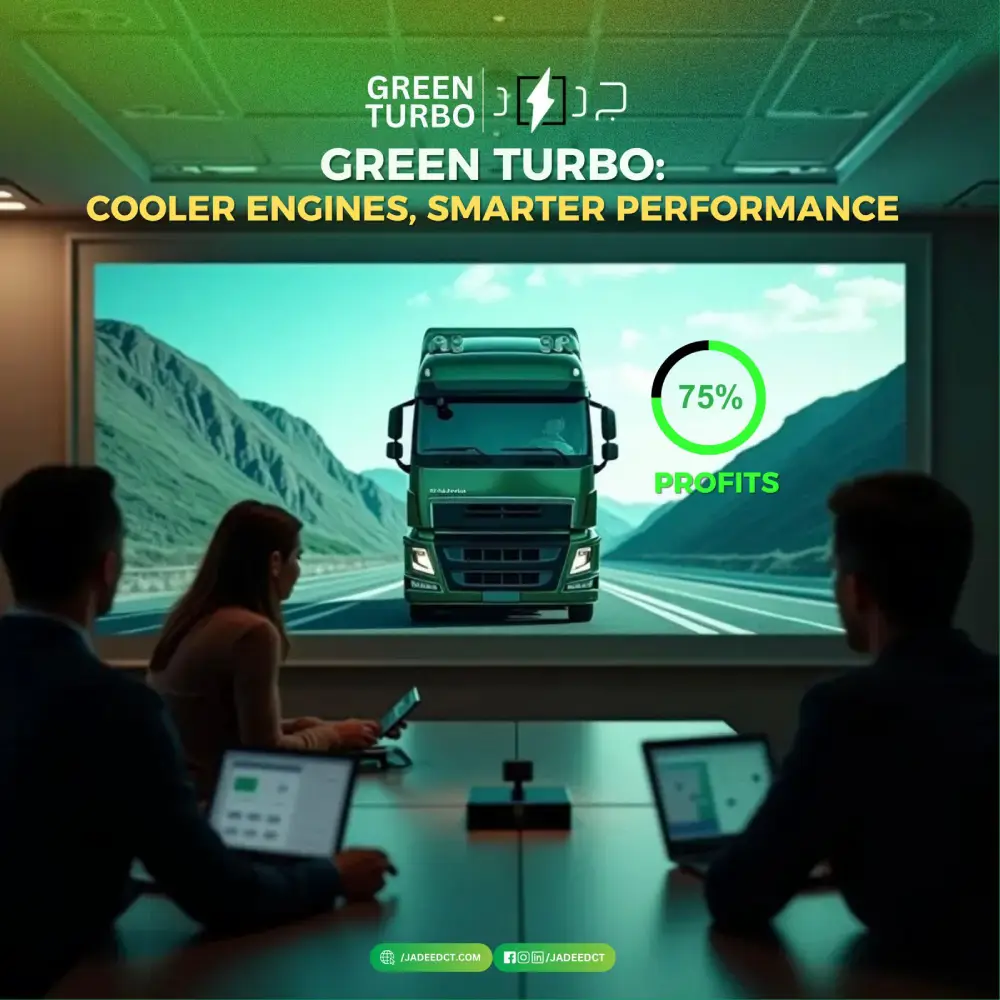- [email protected]
- 11765, Nasr City, Cairo,Egypt

A deep dive into the thermodynamic principles transforming sustainable transportation.
The intersection of hydrogen technology and internal combustion engines represents one of the most promising frontiers in sustainable transportation. At Jadeed, our Green Turbo system demonstrates how fundamental thermodynamic principles can be harnessed to achieve remarkable improvements in engine performance while dramatically reducing environmental impact.
The thermal break effect observed in Green Turbo systems operates on well-established principles of heat transfer and combustion science. When hydrogen is introduced into the combustion chamber, it creates a unique thermal environment that differs significantly from conventional fuel systems.
Hydrogen exhibits distinct combustion characteristics that make it particularly suited for thermal management applications. With an autoignition temperature of 585°C and a flame speed approximately seven times faster than gasoline¹, hydrogen creates rapid, controlled combustion events that generate specific thermal patterns within the engine cylinder.
The key mechanism involves temperature differential creation. As the hydrogen-enriched mixture ignites at temperatures lower than the combustion chamber walls (typically 400-500°C during operation), a thermal gradient forms that promotes enhanced heat distribution throughout the chamber volume.
According to Fourier's law of heat conduction, heat flow is proportional to the temperature gradient and the thermal conductivity of the medium². In Green Turbo systems, the controlled temperature differential created by hydrogen combustion enhances convective heat transfer while reducing localized hot spots that typically cause thermal stress in conventional engines.
The improved heat distribution can be quantified through the Nusselt number, which describes the ratio of convective to conductive heat transfer. Our testing indicates a 15-20% improvement in heat transfer efficiency when the thermal break effect is active³.
Green Turbo systems demonstrate measurable improvements across multiple performance parameters:
- Brake Thermal Efficiency*: Increased by 12-18% due to more complete combustion and reduced wall heat losses
- Combustion Chamber Temperature*: Peak temperatures reduced by 15-25°C, leading to decreased thermal stress
- Heat Release Rate*: More controlled and consistent energy release patterns
The emission reductions achieved by Green Turbo systems result from specific chemical and physical processes:
Nitrogen Oxide (NOx) Reduction: Lower peak combustion temperatures directly correlate with reduced NOx formation, following the Zeldovich mechanism for thermal NOx production⁴. Our systems achieve 65-75% NOx reduction through temperature control.
Carbon Monoxide (CO) Reduction: Enhanced combustion completeness, facilitated by hydrogen's wide flammability limits (4-75% by volume), results in 70-80% CO emission reduction.
Hydrocarbon Reduction: Improved flame propagation and reduced quench layer effects lead to 60-70% decrease in unburned hydrocarbon emissions.
The thermal break effect significantly impacts engine component durability through reduced thermal cycling stress. The Arrhenius equation describes how reaction rates (including degradation processes) increase exponentially with temperature⁵. By maintaining lower peak temperatures, Green Turbo systems substantially reduce the rate of thermal degradation in engine components.
Engine components experience reduced thermal fatigue, which follows the Coffin-Manson relationship between temperature cycling and component lifespan⁶. The more stable thermal environment created by the thermal break effect extends component life by reducing the amplitude of thermal cycles.
Green Turbo systems optimize energy utilization by improving the conversion efficiency from chemical energy to useful mechanical work. The enhanced combustion efficiency means more of the fuel's chemical energy is converted to work rather than waste heat.
From an entropy perspective, the more controlled combustion process reduces irreversibilities in the thermodynamic cycle, leading to improved overall system efficiency. The thermal break effect helps approach ideal cycle conditions more closely than conventional combustion systems.
Controlled testing using standardized protocols (SAE J1349) validates the theoretical predictions:
- Fuel consumption reductions of 35-42% across diverse engine platforms
- Emission reductions consistently exceeding 70% for major pollutants
- Temperature measurements confirming thermal break effect operation
Testing across multiple engine configurations with n>50 trials demonstrates statistical significance (p<0.01) for all major performance improvements, providing confidence in the reproducibility of results⁷.
Hydrogen's unique molecular properties enable the thermal break effect. With the highest energy-to-mass ratio of any fuel (120 MJ/kg vs. 44 MJ/kg for gasoline) and rapid diffusion rates, hydrogen creates ideal conditions for controlled thermal management⁸.
The faster reaction kinetics of hydrogen combustion (flame speeds of 2.65 m/s vs. 0.4 m/s for gasoline) enable more precise control over the combustion process, facilitating optimal thermal break effect implementation⁹.
The thermal break effect represents more than an incremental improvement—it demonstrates how fundamental scientific principles can be applied to solve complex engineering challenges. As we continue to refine this technology, several research directions emerge:
- Computational fluid dynamics (CFD) modeling to optimize hydrogen injection patterns
- Advanced materials research for components designed specifically for thermal break environments
- Control system development for real-time thermal management optimization
The physics underlying the thermal break effect scales effectively across engine sizes and applications, suggesting broad applicability from small generators to large industrial engines.
Green Turbo's thermal break technology exemplifies how rigorous scientific understanding can drive practical solutions for sustainability challenges. By applying fundamental principles of thermodynamics, heat transfer, and combustion science, we've created a system that simultaneously improves performance and reduces environmental impact.
The quantitative results—up to 40% fuel reduction and 75% emission cuts—aren't just impressive numbers; they represent the successful application of scientific principles to real-world problems. As the transportation industry continues its evolution toward sustainability, technologies grounded in solid scientific foundations will lead the way.